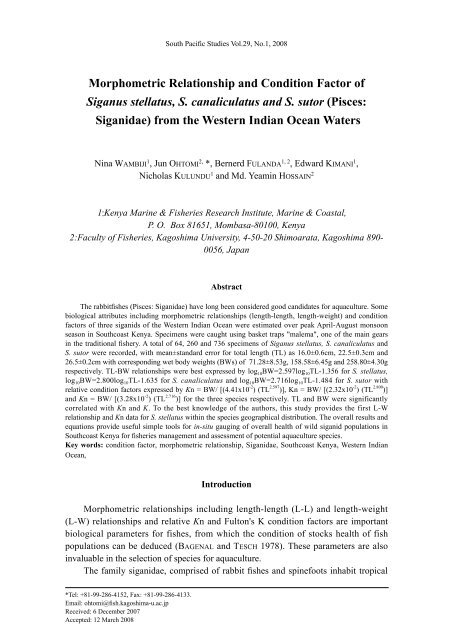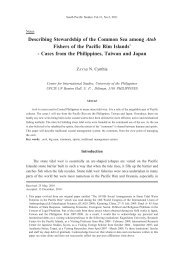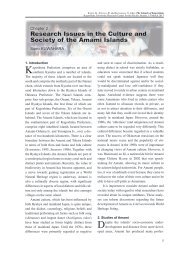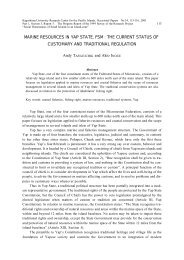Morphometric Relationship and Condition Factor of Siganus ...
Morphometric Relationship and Condition Factor of Siganus ...
Morphometric Relationship and Condition Factor of Siganus ...
Create successful ePaper yourself
Turn your PDF publications into a flip-book with our unique Google optimized e-Paper software.
6 South Pacific Studies Vol.29, No.1, 2008Fig. 4. Total length frequency distribution for <strong>Siganus</strong> canaliculatus in Diani, Msambweni <strong>and</strong> Shimonisites <strong>of</strong> the Western Indian Ocean waters <strong>of</strong> Kenya in the present study, April through August, 2007.n = samples size.Fig. 5. Total length frequency distribution for <strong>Siganus</strong> sutor in Diani <strong>and</strong> Shimoni sites <strong>of</strong> the WesternIndian Ocean waters <strong>of</strong> Kenya in the present study, April through August, 2007. (n = samples size).with mean 22.5±0.3cm TL. A clear unimodal distribution was noted in S. canaliculatusat Shimoni site although the 34cm-35.9cm <strong>and</strong> 34cm– 37.9cm size classes wereabsent in both Diani <strong>and</strong> Shimoni (Fig. 4). Similarly, the 28.0cm+ TL size class was
WAMBIJI N et. al: <strong>Morphometric</strong> <strong>Relationship</strong> <strong>of</strong> Three Siganids7Table 2. Overall length-length (SL-TL) <strong>and</strong> length-weight (TL-BW) relationships <strong>and</strong> relative condition factor (Kn) equations, <strong>and</strong> coefficient <strong>of</strong> determination (r 2 ) for Kn<strong>and</strong> K with total length (TL, cm) <strong>and</strong> wet body weight (BW, g) for <strong>Siganus</strong> stellatus, S. canaliculatus <strong>and</strong> S. sutor (Pisces: Siganidae) in Diani, Msambweni <strong>and</strong>Shimoni on the Western Indian Ocean waters <strong>of</strong> Kenya in the present study, April through August, 2007r 2 , for correlation betweenSpecies n SL-TL relationship TL-BW relationship KnKn-TL Kn-BW K -TL K -BW<strong>Siganus</strong> stellatus 64SL = 0.867 TL -1.544(r 2 = 0.988)BW = (4.41 x 10 -2 )(TL 2.597 )(r 2 = 0.989)Kn= BW/[(4.41x10 -2 )(TL 2.597 ) 0.349* 0.345* 0.667* 0.648*<strong>Siganus</strong> canaliculatus 260SL = 0.849 TL -1.121(r 2 = 0.982)BW = (2.32 x 10 -2 )(TL 2.800 )(r 2 = 0.973)Kn= BW/[(2.32x10 -2 )(TL 2.80 0) 0.130* 0.205* 0.167* 0.069*<strong>Siganus</strong> sutor 736SL = 0.824 TL -0.220(r 2 = 0.943)BW = (3.28 x 10 -2 )(TL 2.716 )(r 2 = 0.909)Kn= BW/[(3.28x10 -2 )(TL 2.716 ) 0.009* 0.141* 0.097* 0.001** shows significance (P 0.01), n = samples size
8 South Pacific Studies Vol.29, No.1, 2008Fig. 6. <strong>Relationship</strong> between logarithm <strong>of</strong> body weight (g) (log10BW) <strong>and</strong> logarithm <strong>of</strong> total length (cm)(log10TL) for <strong>Siganus</strong> stellatus (a), S. canaliculatus (b) <strong>and</strong> S. sutor (c) (Pisces: Siganidae) in Diani,Msambweni <strong>and</strong> Shimoni <strong>of</strong> the Western Indian Ocean waters <strong>of</strong> Kenya in the present study, Aprilthrough August, 2007.not encountered in Msambweni samples. Site analyses showed highly significantdifferences observed in S. canaliculatus (P < 0.001, Kruskal-Wallis test) with Dianirecording larger specimens at 25.1±0.6cm TL compared to 18.2±0.6cm in Msambweni
WAMBIJI N et. al: <strong>Morphometric</strong> <strong>Relationship</strong> <strong>of</strong> Three Siganids9<strong>and</strong> 22.7±0.4cm in Shimoni (P < 0.01 for all pairs, Steel-Dwass test).In S. sutor, a total <strong>of</strong> 736 specimens caught in Diani <strong>and</strong> Shimoni recorded26.5±0.2cm TL with near-normal distributions in both sites (Fig. 5). There was notableabsence <strong>of</strong> S. sutor specimens in Msambweni site <strong>and</strong> like in S. canaliculatus, theDiani site recorded significantly larger specimens compared to Shimoni, at 27.2±0.2cm<strong>and</strong> 26.1±0.2cm TL respectively (P < 0.001, U-test).The L-L changes occurring with growth in the three siganids <strong>of</strong> Southcoast Kenyawere best described by equations SL = 0.867TL-1.544 for S. stellatus, SL = 0.849TL-1.121 for S. canaliculatus <strong>and</strong> SL = 0.824TL-0.220 for S. sutor (Table 2).Length-weight relationships <strong>and</strong> condition factorsWet BWs ranged from 25.27 to 289.20g in S. stellatus, 16.33 to 650.27g in S.canaliculatus <strong>and</strong> 30.10-1009.07g in S. sutor with mean±SE calculated as 71.28±8.53g,158.58±6.45g <strong>and</strong> 258.80±4.30g for the three species respectively (Table 1).Taking into account potential morphometric differences by species,L-W relationships for the three species were best expressed by the equationslog 10 BW = 2.597log 10 TL-1.356, log 10 BW = 2.800log 10 TL–1.635 <strong>and</strong> log 10 BW =2.716log 10 TL-1.484 for S. stellatus, S. canaliculatus <strong>and</strong> S. sutor respectively (Fig.6). Using the slope b <strong>and</strong> intercept a from the power function <strong>of</strong> BL-TL relationship,the relative condition factor for each species was best expressed by the equations Kn=BW/ [(4.41x10-2) (TL 2.597 )] for S. stellatus, Kn =BW/ [(2.32x10 -2 ) (TL 2.800 )] for S.canaliculatus <strong>and</strong> Kn =BW/ [(3.28x10 -2 ) (TL 2.716 )] for S. sutor (Table 2).<strong>Siganus</strong> stellatus recorded similar fish conditions in both Msambweni <strong>and</strong>Shimoni, (P = 0.620 for Kn <strong>and</strong> 0.659 for K, U-test). However, significantly better fishcondition was recorded in Diani for S. canaliculatus <strong>and</strong> S. sutor (P < 0.001, U-test).In overall, S. stellatus <strong>and</strong> S. sutor recorded similar but significantly better relativecondition factor Kn than S. canaliculatus. In contrast, Fulton’s condition factor Kshowed significant variation among all the three species, with best performance byS. stellatus, S. sutor <strong>and</strong> S. canaliculatus in that order, calculated as 1.471±0.021,1.317±0.008 <strong>and</strong> 1.259±0.010 respectively (P < 0.001, Kruskal-Wallis test; P < 0.01for all pairs, Steel-Dwass test) (Table 1). There was a positive correlation for Kn <strong>and</strong> Kwith TL <strong>and</strong> BW for all the three species (P < 0.01 for all groups, Pearson’s correlationtest) (Table 2).DiscussionThe siganid fishes <strong>of</strong> the WIO waters <strong>of</strong> Diani, Msambweni <strong>and</strong> Shimoni fisheriesin Southcoast Kenya were in the same range <strong>of</strong> morphometric parameters <strong>and</strong> bodycondition factors reported for fisheries within similar latitude ranges. In the presentstudy, the largest S. stellatus specimen encountered at 30.5cm TL in Shimoni wasnear the upper end <strong>of</strong> growth ranges (40cm TL) reported for this species (WOODLAND
10 South Pacific Studies Vol.29, No.1, 2008Table 1. <strong>Morphometric</strong> measurements (st<strong>and</strong>ard length, SL; total length, TL; body weight, BW) <strong>and</strong>, relative (Kn) <strong>and</strong> Fulton’s (K) condition factors for <strong>Siganus</strong> stellatus, S.canaliculatus <strong>and</strong> S. sutor (Pisces: Siganidae) in Diani, Msambweni <strong>and</strong> Shimoni, on the Western Indian Ocean waters <strong>of</strong> Kenya in the present study, April throughAugust, 2007Mean ± st<strong>and</strong>ard error (SE)Species Study site n SL (cm) TL (cm) BW (g) Relative KnFulton’s K<strong>Siganus</strong> stellatus Diani 0 ― ― ― ― ―Msambweni 4 11.3±0.4 14.0±0.4 42.25±4.01 1.120±0.414 1.530±0.053Shimoni 60 12.5±0.6 16.2±0.7 73.23±9.04 1.0933±.012 1.468±0.022Pooled 64 12.4±0.5 a 16.0±0.6 a 71.28±8.53 a 1.095±0.112 a 1.471±0.021 a<strong>Siganus</strong> canaliculatus Diani 60 20.3±0.5 a* 25.1±0.6 a* 211.85±14.11 a* 1.038±0.016 a* 1.259±0.023Msambweni 54 14.3±0.5 b* 18.2±0.6 b* 86.83±7.57 b* 0.909±0.018 b* 1.251±0.022Shimoni 146 18.2±0.3 c* 22.7±0.4 c* 163.22±8.36 c* 0.997±0.008 a* 1.261±0.012Pooled 260 17.8±0.3 b 22.5±0.3 b 158.58±6.45 b 0.988±0.007 b 1.259±0.010 b<strong>Siganus</strong> sutor Diani 336 22.1±0.2 a* 27.2±0.2 a* 292.55±6.45 a* 1.191±0.009 a* 1.397±0.012 a*Msambweni 0 ― ― ― ― ―Shimoni 400 21.3±0.2 b* 26.1±0.2 b* 230.46±5.38 b* 1.047±0.008 2b* 1.249±0.010 b*Pooled 736 21.7±0.1 c 26.5±0.2 c 258.80±4.30 c 1.112±0.006 a 1.317±0.008 ca, b, c indicate significant differences between species <strong>and</strong> a*, b*, c* study sites (P 0.01); same letters after mean denote lack <strong>of</strong> significant differences between siteswithin species or between species (pooled). n = sample size.
12 South Pacific Studies Vol.29, No.1, 2008Population age significantly influences L-L <strong>and</strong> L-W relationships <strong>and</strong>consequently the Kn <strong>and</strong> K condition factors. The observed SL-TL <strong>and</strong> TL-BWrelationships in the present study show that siganid populations <strong>of</strong> the WIO waters<strong>of</strong> Southcoast Kenya are still young. Sexes were not determined conclusively in thepresent study but literature indicates differential growth in sexes, though differencesmay not be observable until the females have matured <strong>and</strong> reproduced several times(JOHNSON <strong>and</strong> GILL 1998, NELSON <strong>and</strong> WILKINS 1993). Further, morphologicaldifferences exist between juveniles <strong>and</strong> adults, with early maturity in males throughout the family (NELSON 1994, THRESHER 1984, WHEELER 1975). However, lack <strong>of</strong>observable differences between sexes (KUITER 1993, THRESHER 1984) made externalsex determination difficult except hence this was only done by dissecting for gonadsin a few specimens. Consequently, the L-L <strong>and</strong> L-W relationships <strong>and</strong> Kn equationspresented herein may be used to conclusively distinguish sexes in the siganids <strong>of</strong> WIOwaters. Therefore, caution should be exercised when assessing sex differences by use<strong>of</strong> growth <strong>and</strong> condition factor equations except where sexes have been determined,refining the present equations into sex-specific SL-TL <strong>and</strong> TL-BW relationships <strong>and</strong>Kn <strong>and</strong> K values. Notwithst<strong>and</strong>ing, the broad spectrum <strong>of</strong> gonadal maturity stagesfor these species with all year-round spawning <strong>and</strong> with visible peaks only in spring<strong>and</strong> early summer, <strong>and</strong> a prominent lunar rhythm (THRESHER 1984) calls for cautionwhen assessing the populations. Further, intermittent spawning with non uniformsexual activity <strong>and</strong> spawning within the adult population during any particularseason also calls for caution THRESHER (1984). Moreover, ovarian <strong>and</strong> testiculardevelopment studies show that many species gain water weight during food scarcitytherefore masking the effect <strong>of</strong> nutrition on body condition (BEAMISH et al. 1996).Independent variation between water weight <strong>and</strong> fat weight thus makes interpretation<strong>of</strong> body condition as a measure <strong>of</strong> nutritional reserves difficult (SUTTON et al. 2000).Notwithst<strong>and</strong>ing, the equations developed from the present study for the SL-TL <strong>and</strong>TL-BW relationship, <strong>and</strong> conditions factors Kn <strong>and</strong> K for the siganids <strong>of</strong> the WIOwaters provide a useful in-vitro tool for assessing the individual species <strong>and</strong> generalhealth <strong>of</strong> the siganids stocks.ConclusionThe present study determined the SL-TL, TL-BW relationship for S. stellatus,S. canaliculatus <strong>and</strong> S. sutor <strong>of</strong> the WIO waters caught during the peak SEM April-August season <strong>and</strong> the TL-BW relationships were used to develop condition factorequations for the three species. The SL-TL <strong>and</strong> TL-BW relationships <strong>and</strong> conditionKn <strong>and</strong> K factor values obtained were comparable with siganid populations within thesame geographical range. The Diani site recorded higher Kn <strong>and</strong> K values comparedto the other two sites, probably indicative <strong>of</strong> better food resources, signaling residualeffects <strong>of</strong> the beach management program in supporting a relatively healthy population.The SL-TL <strong>and</strong> TL-BW relationships <strong>and</strong> Kn <strong>and</strong> K equations developed are importantin assessing population health within the fisheries <strong>of</strong> the WIO waters. Caution should
WAMBIJI N et. al: <strong>Morphometric</strong> <strong>Relationship</strong> <strong>of</strong> Three Siganids13however be exercised when interpreting <strong>and</strong> comparing results <strong>of</strong> body condition datafor stock health assessment <strong>of</strong> individuals as shown by the wide distribution <strong>of</strong> S.stellatus, though with fewer samples compared to S. canaliculatus <strong>and</strong> S. sutor. To thebest knowledge <strong>of</strong> the authors, this study provides the initial data on L-W relationship<strong>and</strong> Kn for S. stellatus within the species geographical distribution. The results <strong>of</strong>the present study <strong>and</strong> equations developed herein provide useful simple tools for insitugauging <strong>of</strong> overall health <strong>of</strong> wild siganid populations in the WIO eco-region forsustainable fisheries. The equations would also provide useful comparisons betweenwild <strong>and</strong> cultured populations <strong>of</strong> the three siganid fishes.AcknowledgementsThe authors would like to thank the Director, Kenya Marine <strong>and</strong> FisheriesResearch Institute for financial <strong>and</strong> logistical support in the research initiative for theSouthcoast fisheries within the Western Indian Ocean; to fellow researchers for supportin scheduling <strong>and</strong> structuring the methodology <strong>and</strong>, to the fishers <strong>of</strong> Southcoast Kenyafor their patience with the traps <strong>and</strong> sampling period. It is our hope that the results <strong>of</strong>the present study go along way in helping sustain the siganid fisheries <strong>of</strong> the WIO ecoregion<strong>and</strong> improve fisher livelihoods.ReferencesAHMAD, A.T.B., ISA, M.M., ISMAIL, M.S. <strong>and</strong> YUSOF, S. 2003. Status <strong>of</strong> demersalfishery resources <strong>of</strong> Malaysia. In: Assessment, management <strong>and</strong> future directionsfor coastal fisheries in Asian countries, (Ed. SILVESTRE, G., GARCES, L.,STOBUTZKI, I., AHMED, M., VALMONTE-SANTOS, R.A., LUNA, C., LACHINCA-ALINO,L., MUNRO, P., CHRISTENSEN V. <strong>and</strong> PAULY D.), pp. 83-135, WorldFish CenterConference Proceedings No. 67.BAGENAL, T. B. <strong>and</strong> TESCH, F.W. 1978. Age <strong>and</strong> growth In: Methods for assessment<strong>of</strong> fish production in fresh waters 3rd Edition, (Ed. BAGENAL, T.), 101–136. IBPH<strong>and</strong>book No. 3, Blackwell, Oxford.BEAMISH, F.W., SITJA-BOBADILLA, A., JEBBINK J.A. <strong>and</strong> WOO P.T.K. 1996. Bioenergeticcost <strong>of</strong> cryptobiosis in fish: rainbow trout Oncorynchus mykiss infected withCryptobia salmositica <strong>and</strong> with an attenuated live vaccine. Dis. Aquat. Org., 25,1- 8.BRYAN, P.G., MADRAISAU, B.B., <strong>and</strong> McVEY, J.P. 1975. Hormone induced <strong>and</strong> naturalspawning <strong>of</strong> captive <strong>Siganus</strong> canaliculatus (Pisces: Siganidae) year round.Micronesica 11, 199-204.De SOUZA, T.F. 1988. Reproduction, length-weight relationship <strong>and</strong> condition factorin<strong>Siganus</strong> sutor (VALENCIENNES, 1835) (Pieces: Siganidae) from the Kenya waters<strong>of</strong> the Western Indian Ocean. Kenya J. Sci. B., 9, 89-101.FAO, 1998. Year Book <strong>of</strong> 1996, Fisheries statistics Vol. 82. 678 pp., Food <strong>and</strong>
14 South Pacific Studies Vol.29, No.1, 2008Agricultural Organization <strong>of</strong> the United Nations, Rome, Italy.GEORGE, C.J. 1972. Notes on the breeding <strong>and</strong> movement <strong>of</strong> rabbit fishes <strong>Siganus</strong>rivulatus (FORSSKAL) <strong>and</strong> <strong>Siganus</strong> luridus (RUPPELL) in coastal waters <strong>of</strong> Lebanon,Annali del Museo Civico di Storia naturale Giaccomo Doria, 79, 32-44.GRANDCOURT, E.M. 2002. Demographic characteristics <strong>of</strong> a selection <strong>of</strong> exploited reeffish from the Seychelles: preliminary study. Mar. Freshwat. Res., 53, 123-130.GUARD, M. 1999. Artisanal fisheries <strong>of</strong> southern Tanzania, data collection methods,status <strong>of</strong> fisheries <strong>and</strong> resource use management. In: Fisheries stock assessment inthe traditional fishery sector: The information needs, proceedings <strong>of</strong> the nationalworkshop on the artisanal fisheries sector, September 22-24, 1997 (Ed. N. S.JIDDAWI AND STANLEY, R.D.). 35 - 47., Zanzibar, Tanzania,GUNDERMANN, N., POPPER, D.M <strong>and</strong> LICHATOWICH, T. 1983. Biology <strong>and</strong> life cycle <strong>of</strong><strong>Siganus</strong> vermiculatus (Siganidae: Pisces). Pac. Sci., 37, 165-180.HAYES, D.B., BRODZIAK J.K.T <strong>and</strong> O'GORMAN, J.B. 1995. Efficiency <strong>and</strong> Bias <strong>of</strong>Estimators <strong>and</strong> Sampling Designs for Determining Length–Weight <strong>Relationship</strong>s<strong>of</strong> Fish. Can. J. Fish. Aquat. Sci., 52, 84 - 92.HORRIL, C. <strong>and</strong> KAMAU I. (ed.) 2001. Proceedings <strong>of</strong> the Eastern African marine ecoregionvisioning workshop, 21 st -24th April, 2001. 86 pp., Mombasa, Kenya.JEHANGEER, M.I. 1988. Preliminary estimates <strong>of</strong> age, growth <strong>and</strong> mortality <strong>of</strong> <strong>Siganus</strong>sutor from Mauritius In: Proceedings <strong>of</strong> the workshop on the assessment <strong>of</strong> thefishery resources in the Southwest Indian Ocean (Ed. by SANDERS, M.J., SPARRE, P.<strong>and</strong> VENEMA, S.C.) FAO/UNDP: RAF/79/065/WP/41/88/E, 254- 59, FAO, Italy.JEYASEELAN, M.J. 1998. Manual <strong>of</strong> fish eggs <strong>and</strong> larvae from Asian mangrovewaters. 193 pp., United Nations Educational, Scientific <strong>and</strong> Cultural Organization,Paris, France.JOHNSON, G. AND GILL, A. 1998. Perches <strong>and</strong> their allies. In: Encyclopedia <strong>of</strong> fishes2nd Edition (Ed. ESCHMEYER W.N. <strong>and</strong> PAXTON, J.R.). 191 pp., Academic PressSan Diego, CA.JONES, L.L.C. 1981. A Review <strong>of</strong> the rabbitfishes. Freshwat. Mar. Aquar., 4 (10), 42-67.KAMUKURU, A.T. 2006. Reproductive biology <strong>of</strong> the white spotted rabbitfish, <strong>Siganus</strong>sutor (Pisces: Siganidae) from basket trap fishery in Dares Salaam marine reservesystems, Tanzania. 31 pp., Western Indian Ocean Marine Sciences Association,MARG-I/2006-01, Zanzibar, Tanzania.KUITER, R. 1993. Coastal fishes <strong>of</strong> Southeastern Australia. Honolulu. 437 pp.,University <strong>of</strong> Hawaii Press.Le CREN, E.D. 1951. The Length-Weight <strong>Relationship</strong> <strong>and</strong> Seasonal Cycle in GonadWeight <strong>and</strong> <strong>Condition</strong> in Perch, Perca fluviatilis, J. Anim. Ecol., 20, 201–219.MURPHY, B.R., WILLIS D.W. <strong>and</strong> SPRINGER T.A. 1991. The Relative Weight Index inFisheries Management: Status <strong>and</strong> Needs. Fisheries (Bethesda), 16 (2), 30-39.NELSON, J. 1994. Fishes <strong>of</strong> the World, 3 rd Edition, New York, N.Y. John Wiley <strong>and</strong>Sons, 594 pp.
WAMBIJI N et. al: <strong>Morphometric</strong> <strong>Relationship</strong> <strong>of</strong> Three Siganids15NELSON, S. <strong>and</strong> WILKINS, S. 1993. Growth <strong>and</strong> Respiration <strong>of</strong> Embryos <strong>and</strong> Larvae <strong>of</strong>the Rabbitfish <strong>Siganus</strong> r<strong>and</strong>alli (Pisces: Siganidae), J. Fish Bio., 44, 513-525.NTIBA, M.J. <strong>and</strong> JACCARINI, V. 1988. Age <strong>and</strong> Growth Parameters <strong>of</strong> <strong>Siganus</strong> sutorin Kenyan Marine Inshore Waters Derived from Numbers <strong>of</strong> Otolith Micro b<strong>and</strong>s<strong>and</strong> Fish Lengths, J. Fish Biol., 33, 465-470.NTIBA, M.J. <strong>and</strong> JACCARINI, V. 1990. Gonad Maturation <strong>and</strong> Spawning times <strong>of</strong><strong>Siganus</strong> sutor <strong>of</strong>f the Kenya Coast: Evidence for Definite Spawning Seasons inTropical Fish, J. Fish Biol., 37, 315-325.PAULY, D. 1978. A Preliminary Compilation <strong>of</strong> Fish Length Growth Parameters, Ber.Inst. Meereskd. Christian-Albrechts-Univ Kiel 55, 200 pp.SAMBOO, C.R. <strong>and</strong> MAUREE, D. 1988. Summary <strong>of</strong> fisheries <strong>and</strong> resource informationfor Mauritius In: Proceedings <strong>of</strong> the Workshop on the Assessment <strong>of</strong> the FisheryResources in the Southwest Indian Ocean (Ed. by SANDERS, M.J., SPARRE, P. <strong>and</strong>VENEMA, S.C.) FAO/UNDP: RAF/79/065/WP/41/88/E, 62-79, FAO, Italy.SUTTON, S.G., BULT, T.P. <strong>and</strong> HAEDRICH, R.L. 2000. <strong>Relationship</strong>s Among Fat Weight,Body Weight, Water Weight, <strong>and</strong> <strong>Condition</strong> <strong>Factor</strong>s in Wild Atlantic Salmon Parr.,Trans. Am. Fish. Soc., 129, 527–538.THRESHER, R. 1984. Reproduction in Reef Fishes, Neptune City, NJ, T.F.H.Publications, 399 pp.WASSEF, E.A. <strong>and</strong> ABDUL-HADY, H.A. 1997. Breeding Biology <strong>of</strong> Rabbitfish <strong>Siganus</strong>canaliculatus (Siganidae) in Mid Arabian Gulf. Fish. Res., 33 (1-3), 159-166.WHEELER, A. 1975. Fishes <strong>of</strong> the World, an Illustrated Dictionary. 366 pp., FerndaleEditions, London.WOODLAND, D.J. 1986. Siganidae In: Smiths' Sea Fishes (Ed. SMITH, M.M. <strong>and</strong>HEEMSTRA, P.C.), 824-825, Springer-Verlag, Berlin.WOODLAND, D.J. 1990. Revision <strong>of</strong> the Fish Family Siganidae with Descriptions <strong>of</strong>Two New Species <strong>and</strong> Comments on Distribution <strong>and</strong> Biology. Indo-PacificFishes, 19, 1-136 pp.YANAGAWA, H. 1994. Length-Weight <strong>Relationship</strong> <strong>of</strong> Gulf <strong>of</strong> Thail<strong>and</strong> Fishes, NAGAICLARM Q., 17 (4), 48-52.
16 South Pacific Studies Vol.29, No.1, 2008







